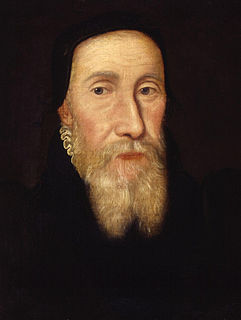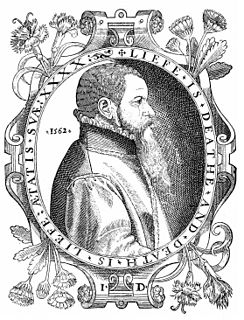Related Research Articles

John Badby (1380–1410), one of the early Lollard martyrs, was a tailor in the west Midlands, and was condemned by the Worcester diocesan court for his denial of transubstantiation.

Hugh Latimer was a Fellow of Clare College, Cambridge, and Bishop of Worcester during the Reformation, and later Church of England chaplain to King Edward VI. In 1555 under the Catholic Queen Mary I he was burned at the stake, becoming one of the three Oxford Martyrs of Anglicanism.

John Foxe, an English historian and martyrologist, was the author of Actes and Monuments, telling of Christian martyrs throughout Western history, but particularly the sufferings of English Protestants and proto-Protestants from the 14th century and in the reign of Mary I. The book was widely owned and read by English Puritans and helped to mould British opinion on the Catholic Church for several centuries.
John Taylor was an English churchman and academic, Bishop of Lincoln from 1552 to 1554.

Edwin Sandys was an English prelate. He was Anglican Bishop of Worcester (1559–1570), London (1570–1576) and Archbishop of York (1576–1588) during the reign of Elizabeth I of England. He was one of the translators of the Bishops' Bible.

Martyr's Mirror or The Bloody Theater, first published in Holland in 1660 in Dutch by Thieleman J. van Braght, documents the stories and testimonies of Christian martyrs, especially Anabaptists. The full title of the book is The Bloody Theater or Martyrs Mirror of the Defenseless Christians who baptized only upon confession of faith, and who suffered and died for the testimony of Jesus, their Saviour, from the time of Christ to the year A.D. 1660. The use of the word defenseless in this case refers to the Anabaptist belief in non-resistance. The book includes accounts of the martyrdom of the apostles and the stories of martyrs from previous centuries with beliefs similar to the Anabaptists.

John Day was an English Protestant printer. He specialised in printing and distributing Protestant literature and pamphlets, and produced many small-format religious books, such as ABCs, sermons, and translations of psalms. He found fame, however, as the publisher of John Foxe's Actes and Monuments, also known as the Book of Martyrs, the largest and most technologically accomplished book printed in sixteenth-century England.

John Bradford (1510–1555) was an English Reformer, prebendary of St. Paul's, and martyr. He was imprisoned in the Tower of London for alleged crimes against Queen Mary I. He was burned at the stake on 1 July 1555.

Walter Milne, also recorded as Mill or Myln, was the last Protestant martyr to be burned in Scotland before the Scottish Reformation changed the country from Catholic to Presbyterian.

Robert Horne was an English churchman, and a leading reforming Protestant. One of the Marian exiles, he was subsequently bishop of Winchester from 1560 to 1580.

Thomas Hawkes was an English protestant martyr who burned to death in 1555 during the Marian Persecutions rather than allow his son to be baptised into the Roman Catholic Church.

The Colchester Martyrs were 16th-century English Protestant martyrs. They were executed for heresy in Colchester, Essex, during the reigns of Henry VIII and Mary I. Their story is recorded in Foxe's Book of Martyrs.
Christopher Wade was an English Protestant martyr. His story is recorded in Foxe's Book of Martyrs.
The Canterbury Martyrs were 16th-century English Protestant martyrs. They were executed for heresy in Canterbury, Kent, and were the last Protestants burnt during the reign of Mary I. Their story is recorded in Foxe's Book of Martyrs.
The Windsor Martyrs were English Protestants martyred at Windsor in 1543. Their names were Robert Testwood, Anthony Pearson and Henry Filmer.

The Actes and Monuments, popularly known as Foxe's Book of Martyrs, is a work of Protestant history and martyrology by Protestant English historian John Foxe, first published in 1563 by John Day. It includes a polemical account of the sufferings of Protestants under the Catholic Church, with particular emphasis on England and Scotland. The book was highly influential in those countries and helped shape lasting popular notions of Catholicism there. The book went through four editions in Foxe's lifetime and a number of later editions and abridgements, including some that specifically reduced the text to a Book of Martyrs.

The Stratford Martyrs were eleven men and two women who were burned at the stake together for their Protestant beliefs, either at Stratford-le-Bow, Middlesex or Stratford, Essex, both near London, on 27 June 1556 during the Marian persecutions.

The Guernsey Martyrs were three women who were burned at the stake for their Protestant beliefs, in Guernsey, Channel Islands, in 1556 during the Marian persecutions.
John Philpot was an Archdeacon of Winchester and an English Protestant martyr whose story is recorded in Foxe's Book of Martyrs. He was the third son of Sir Peter Philpot and was born at Compton, Hampshire, in 1516.
References
- ↑ Foxe, John (2005). Foxe's Book of Martyrs (1st ed.). Greenville, SC: Ambassador International. pp. 257–258. ISBN 1932307206.